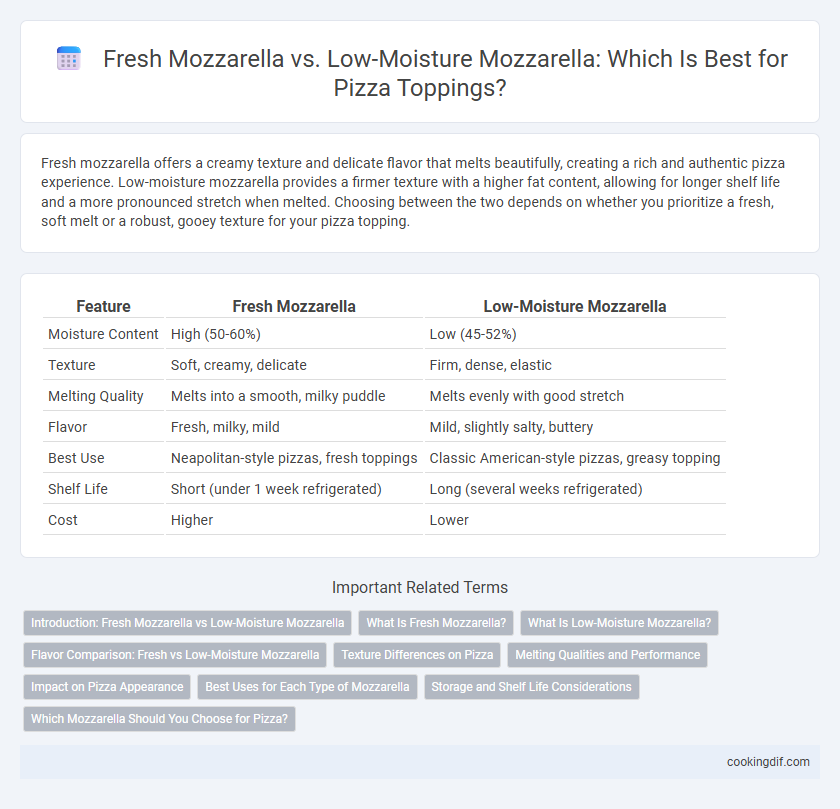Fresh mozzarella offers a creamy texture and delicate flavor that melts beautifully, creating a rich and authentic pizza experience. Low-moisture mozzarella provides a firmer texture with a higher fat content, allowing for longer shelf life and a more pronounced stretch when melted. Choosing between the two depends on whether you prioritize a fresh, soft melt or a robust, gooey texture for your pizza topping.
Table of Comparison
| Feature | Fresh Mozzarella | Low-Moisture Mozzarella |
|---|---|---|
| Moisture Content | High (50-60%) | Low (45-52%) |
| Texture | Soft, creamy, delicate | Firm, dense, elastic |
| Melting Quality | Melts into a smooth, milky puddle | Melts evenly with good stretch |
| Flavor | Fresh, milky, mild | Mild, slightly salty, buttery |
| Best Use | Neapolitan-style pizzas, fresh toppings | Classic American-style pizzas, greasy topping |
| Shelf Life | Short (under 1 week refrigerated) | Long (several weeks refrigerated) |
| Cost | Higher | Lower |
Introduction: Fresh Mozzarella vs Low-Moisture Mozzarella
Fresh mozzarella offers a creamy texture and delicate flavor due to its high moisture content, making it ideal for Neapolitan-style pizzas with a soft, bubbly crust. Low-moisture mozzarella has a denser texture and lower water content, resulting in better meltability and stretch, which works well for classic American-style pizzas that require a longer bake time. Choosing between fresh and low-moisture mozzarella depends on the desired pizza style, moisture control, and melt characteristics.
What Is Fresh Mozzarella?
Fresh mozzarella is a soft, moist cheese made from whole milk, prized for its delicate, milky flavor and creamy texture, often used in authentic Italian pizzas like Margherita. Unlike low-moisture mozzarella, fresh mozzarella contains higher water content, resulting in a softer melt and more pronounced dairy taste. It typically comes in ball or log form, stored in brine or whey to maintain its freshness and prevent drying out during storage and cooking.
What Is Low-Moisture Mozzarella?
Low-moisture mozzarella is a type of cheese with reduced water content, typically around 45-52%, making it firmer and more suitable for melting on pizza. Unlike fresh mozzarella, which contains about 60-65% moisture and has a soft, creamy texture, low-moisture mozzarella offers a more elastic melt and longer shelf life. This cheese is popular for pizza toppings due to its ability to brown evenly and create a stretchy, gooey texture without releasing excess moisture that can make the crust soggy.
Flavor Comparison: Fresh vs Low-Moisture Mozzarella
Fresh mozzarella offers a creamy, milky flavor with a delicate texture that melts smoothly, enhancing the pizza's freshness and providing a subtle tang. Low-moisture mozzarella delivers a more concentrated, slightly salty taste with a firmer texture, producing a browner, bubbly crust ideal for a classic pizza experience. Choosing between the two depends on whether a softer, fresher taste or a more robust, longer-lasting melt is desired for the pizza topping.
Texture Differences on Pizza
Fresh mozzarella offers a creamy, soft texture that melts smoothly, creating a moist and tender topping on pizza, while low-moisture mozzarella provides a firmer, denser consistency that results in a chewier, stringier melt. The higher water content in fresh mozzarella contributes to a slightly saucier, more elastic bite, whereas low-moisture mozzarella's reduced moisture enhances browning and stretches without excess moisture release. Choosing between these varieties affects both the pizza's mouthfeel and how the cheese interacts with the crust and other toppings during baking.
Melting Qualities and Performance
Fresh mozzarella offers a creamy texture and melts smoothly, providing a rich and gooey consistency ideal for Neapolitan-style pizzas. Low-moisture mozzarella, with its lower water content, delivers a firmer melt and better browning, making it perfect for New York-style pizzas that require stretch and bubble formation. The choice between the two impacts the pizza's moisture balance and overall texture during baking.
Impact on Pizza Appearance
Fresh mozzarella creates a glossy, creamy white appearance on pizza, often melting into smooth pools that highlight the toppings underneath, offering a fresh and artisanal look. Low-moisture mozzarella, with its denser texture and higher fat content, browns evenly to produce a golden, bubbly crust that enhances the classic pizzeria style. The choice between the two significantly impacts the pizza's visual appeal, influencing not only color and texture but also the perception of freshness versus traditional baking methods.
Best Uses for Each Type of Mozzarella
Fresh mozzarella offers a creamy texture and delicate flavor ideal for Neapolitan-style pizzas or Caprese toppings, where moisture and fresh dairy taste enhance the dish. Low-moisture mozzarella melts evenly with a stretchier consistency, making it perfect for classic New York-style pizzas and recipes requiring longer baking times. Choosing between fresh and low-moisture mozzarella depends on desired melt, moisture retention, and flavor profile for specific pizza styles.
Storage and Shelf Life Considerations
Fresh mozzarella requires refrigeration and should be consumed within 3 to 5 days after opening due to its high moisture content, which makes it prone to spoilage. Low-moisture mozzarella has a significantly longer shelf life, often lasting several weeks unopened and up to 2 weeks refrigerated once opened. Proper storage in airtight containers helps maintain the texture and flavor of both types, but low-moisture mozzarella offers more convenience for long-term use on pizza toppings.
Which Mozzarella Should You Choose for Pizza?
Fresh mozzarella offers a creamy texture and mild flavor that melts beautifully, making it ideal for Neapolitan-style pizzas where moisture and softness are desired. Low-moisture mozzarella provides a firmer, stretchier melt with less water content, resulting in a crispy crust and longer shelf life suited for New York-style or deep-dish pizzas. Choosing between fresh and low-moisture mozzarella depends on your preferred pizza style, moisture tolerance, and desired melt characteristics.
Fresh mozzarella vs low-moisture mozzarella for topping Infographic

 cookingdif.com
cookingdif.com